Gottstein G., Shvindlerman L.S. Grain Boundary Migration in Metals: Thermodynamics, Kinetics, Applications
Подождите немного. Документ загружается.


526 6 Applications
Since the rotation g is defined on a sphere, f(g) can be readily expanded
in terms of the generalized spherical harmonics T
μν
λ
(which are the known
generalized Legendre polynomials)
f(g)=
∞
λ=0
λ
μ=−λ
λ
ν=−λ
C
μν
λ
T
μν
λ
(g) (6.21)
Expansion of P
hkl
(α, β) in terms of the reduced spherical harmonics k
v
λ
(α, β)
yields
P
hkl
(α, β)=
∞
λ=0
λ
ν=−λ
F
ν
λ
(hkl)k
ν
λ
(α, β) (6.22)
The correlation between Eq. (6.22) and Eq. (6.21) is given by the integral
equation (5.20) which renders the relation of the coefficients F
ν
λ
and C
μν
λ
F
ν
λ
(hkl) =
4π
2λ +1
λ
μ=−λ
C
μν
λ
k
μ
λ
(α, β) (6.23)
Since T
μν
λ
is known analytically, and C
μν
λ
can be calculated from P
hkl
accord-
ing to Eqs.(6.23) and (6.22) [567], f (g) can be computed from Eq. (6.21). For
practical purposes the expansion has to be limited to finite values of λ.
Current evaluation programs commonly truncate for λ>22. Taking into
account specimen and crystal symmetry simplifies the procedure for rolled
cubic crystals considerably. In contrast, textures of materials with low crystal
symmetry (most minerals) are not yet analyzed on a sophisticated level.
The computed result for the Cu-rolling texture is shown as an example in
Fig. 6.11. The lines connect points of 1/2 maximum intensity. The texture
resembles a tube in Euler space. The three-dimensional drawing of contour
lines in orientation space is rather inconvenient. Instead, sections parallel to
ϕ
2
in increments of Δϕ
2
=5
◦
are usually presented in the literature.
It is noted again that in highly symmetric lattices like the cubic structure,
the interpretation of the ODF in Euler space is complicated by the presence
of three crystallographically equivalent orientations in the cell 0 ≤ ϕ
1
, Φ,ϕ
2
≤
π/2. The appropriate unit cell which accounts for specimen symmetry as well
as crystal symmetry can be of rather complicated shape and, therefore, in-
convenient to handle. Usually, the ODF is represented in 0 ≤ ϕ
1
, Φ,ϕ
2
≤ π/2
and the reader has to take note of the multiplicity of symmetric components.
Owing to a long tradition of research on rolling textures in cubic crystals the
most familiar notation of an orientation is still {hkl}uvw. For practical pur-
poses there are conversion tables from {hkl}uvw to (ϕ
1
, Φ,ϕ
2
) to facilitate
evaluation.
© 2010 by Taylor and Francis Group, LLC

6.1 Characterization of Microstructure and Texture 527
(a) (b)
Φ
Φ
π
2
π
2
π
2
ϕ
1
ϕ
1
ϕ
2
(a) (b)
Φ
Φ
π
2
π
2
π
2
π
2
π
2
π
2
ϕ
1
ϕ
1
ϕ
2
FIGURE 6.11
(a) 3D representation of the orientation distribution of rolled high purity
copper in Euler space. Unlike in the 2D pole figure, here an orientation is
represented unambiguously in three coordinates (by three Euler angles); (b)
Illustration of the orientation distribution by sections through Euler space
perpendicular to the angle ϕ
2
at 5
◦
intervals.
6.1.3.6 Quantitative Analysis in Terms of Scattered Ideal Orien-
tations
The contour lines of the ODF are rather inconvenient for practical use. Real
textured material contains, however, strong maxima as well as regions with
virtually zero intensity. The maximum intensity can exceed the intensity of a
random distribution (i.e. distribution of a powder specimen) by a factor of 100
and more. The common way of qualitative texture analysis is, therefore, the
interpretation of pole figures and ODFs in terms of ideal orientations, which
coincide with the dominant maxima in the intensity distribution [572]. When
the intensity maxima are smeared out, there is a certain ambiguity on how
many ideal orientations are necessary to represent the ODF, and what is their
most adequate notation. The Cu-rolling texture is represented in the ODF in
Fig. 6.11 and in the pole figure in Fig. 6.10. The intensity maxima are well
represented by three ideal orientations which are known under the names:
{011}21
¯
1 brass orientation (main component in brass-rolling texture),
{112}11
¯
1 Cu-orientation (main component in Cu-rolling texture) and
{123}63
¯
4 S-orientation (leads to S-shape of Cu-rolling texture).
For a quantitative texture analysis the scatter σ around the ideal orientation
must be taken into account. For this purpose the ODF is fitted by Gauss-type
© 2010 by Taylor and Francis Group, LLC

528 6 Applications
RD
{111}
Φ
ϕ
2
= 0°
ϕ
1
ϕ
2
= 90°
ϕ
2
= const.
5° 15°
25°
10°
30°20° 35°
40° 45° 50° 55°
60° 65° 70° 75°
80° 85°
(a) (b)
FIGURE 6.12
Main rolling texture components of cubic metals. (a) {111} pole figure; (b) in
Euler space.
distributions around ideal orientations [573]:
S
i
(g)=S
i
(g
0
)exp
−
(g − g
0
)
2
σ
2
i
(6.24)
f (g
0
)=
i
S
i
(g) (6.25)
From the result the volume fraction M
i
of each texture component can be
derived by integration of Eq. (6.18) within the orientation regime of each
component and taking note of Eq. (6.19).
M
i
=
1
2
√
π
Z
i
S
i
(g
0
) σ
i
1 − exp
−
σ
2
i
4
(6.26)
Tables 6.1 and 6.2 and Figs. 6.12 and 6.13 summarize the most important
components of the rolling textures (Fig. 6.12) and recrystallization textures,
(Fig. 6.13) of cubic metals and alloys.
6.1.3.7 Misorientation Distributions
While an orientation represents a rotation of the specimen coordinate sys-
tem into the crystal coordinate system, a misorientation corresponds to the
rotation that makes the two crystal orientations coincide. Therefore, a mis-
orientation distribution can be represented like an orientation distribution, in
© 2010 by Taylor and Francis Group, LLC
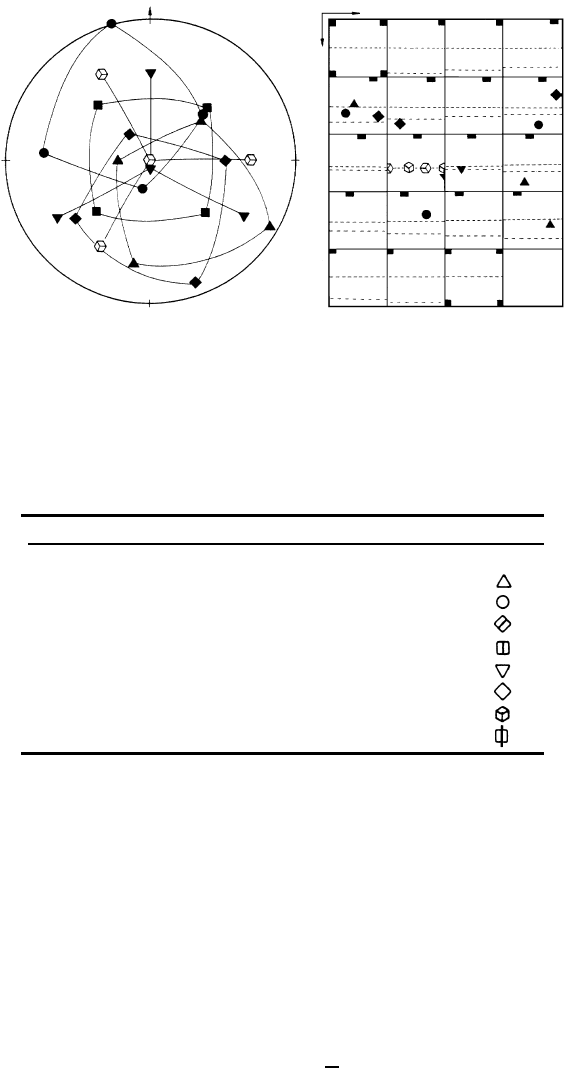
6.1 Characterization of Microstructure and Texture 529
RD
{111}
(a) (b)
Φ
ϕ
2
= 0°
ϕ
1
ϕ
2
= 90°
ϕ
2
= const.
5°
15°
25°
10°
30°20° 35°
40° 45° 50° 55°
60°
65° 70° 75°
80° 85°
FIGURE 6.13
Main recrystallization texture components of cubic metals. (a) {111} pole
figure; (b) in Euler space.
TABLE 6.1
Main Rolling Texture Components of Cubic Metals
Notation {hkl}uvw ϕ
1
Φ ϕ
2
Symbol
C {112}11
¯
1 90
◦
35
◦
45
◦
S {123}63
¯
4 59
◦
37
◦
63
◦
Bs {011}21
¯
1 35
◦
45
◦
0
◦
Goss {011}100 0
◦
45
◦
0
◦
{112}110 0
◦
35
◦
45
◦
Rotated Cube {001}110 45
◦
0
◦
0
◦
{111}11
¯
2 90
◦
55
◦
45
◦
Cube
RD
{025}100 0
◦
22
◦
0
◦
principle. The most commonly used space to represent an orientation distri-
bution is the Euler space, in particular for the reason that the Euler angles
can be handled as independent and separate variables for the computation
of the ODF. Despite its standard use, Euler space has major disadvantages
owing to its severe distortions, in particular for rotations about the z (ND)
direction.
A representation of misorientation more easy to imagine is the notation
in terms of axis n and angle ω of rotation, which can be most conveniently
represented by its Rodrigues vector [574, 575]
R = n · tan
ω
2
(6.27)
© 2010 by Taylor and Francis Group, LLC
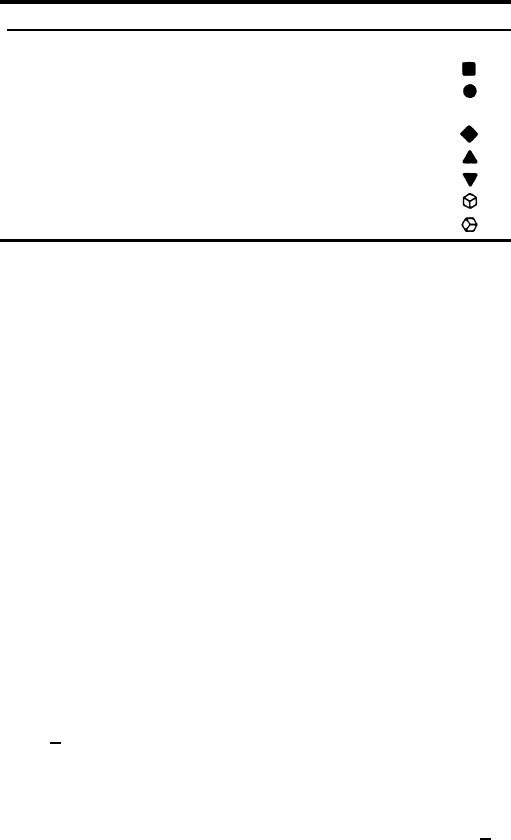
530 6 Applications
TABLE 6.2
Main Recrystallization Texture Components of Cubic
Metals
Notation {hkl}uvw ϕ
1
Φ ϕ
2
Symbol
Cube {001}100 0
◦
0
◦
0
◦
R {123}63
¯
4 59
◦
37
◦
63
◦
or also {124}21
¯
1 57
◦
29
◦
63
◦
bs/R {236}38
¯
5 79
◦
31
◦
33
◦
Intermediate {258}1
¯
21 47
◦
34
◦
22
◦
{554}22
¯
5 90
◦
61
◦
45
◦
{111}11
¯
2 90
◦
55
◦
45
◦
{111}1
¯
10 0
◦
5
◦
45
◦
in Rodrigues space. The coordinate system of Rodrigues space coincides with
the crystal coordinate system, but its unit cell is determined by crystal sym-
metry. Any misorientation can be represented by its Rodrigues vector R,
which is parallel to the rotation axis n (which, by definition, is common to
both lattices), and the length of which is determined by tanω/2. This choice
of vector length results in minimal distortions of misorientation space, i.e. all
volume elements are almost equally large, irrespective of their location. In the
following the geometrical properties of Rodrigues space for cubic crystals will
be addressed more closely.
Because of the high symmetry of cubic crystals their fundamental zone in
Rodrigues space is relatively small and simple. Since there are 24 · 24 = 576
different ways to represent an orientation relationship in cubic crystals, but
only one is needed, a selection is made with regard to the smallest angle of
rotation to define the elementary Rodrigues vector. All possible elementary
Rodrigues vectors define the fundamental zone of Rodrigues space for cubic
crystals (Fig. 6.14). Rodrigues space consists of a cube with the corners cut
off. The Rodrigues vector emerges from the center of the cube and is defined
by its components with regard to the orthogonal axes, which are parallel to
the cubic crystal axes. The maximum length of a Rodrigues vector along the
100 axes is
√
2−1, corresponding to a 45
◦
rotation. The vector of maximum
length is obtained at the corner of a triangular face. The triangular face is
perpendicular to the 111 axis and intersects the cube at an angle of 60
◦
, i.e.
the center of the triangular face is touched by the Rodrigues vector 1/3111.
The corner of the triangular face corresponds to a 62.8
◦
1, 1, (
√
2 − 1) rota-
tion, which is crystallographically equivalent to a 90
◦
110 rotation. It may
be helpful to remember
• small angle rotations are located close to the origin
•100 rotations extend along the coordinate axes
© 2010 by Taylor and Francis Group, LLC
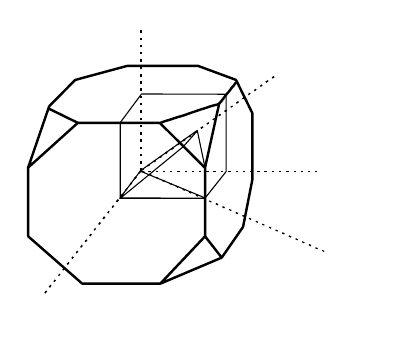
6.1 Characterization of Microstructure and Texture 531
[010]
[100]
[001]
[111]
[110]
[001]
[111]
[010]
[110]
[100]
FIGURE 6.14
Fundamental zone of Rodrigues space.
•110 rotations extend along the cube face diagonals
•111 rotations extend along the cube space diagonal
• twin rotations (60
◦
< 111) are found in the center of the triangular
faces
If positive and negative rotations about crystallographically equivalent axes
are considered to be equivalent, then the fundamental zone of Rodrigues space
can be reduced to 1/48 of its size, which defines the so-called Mackenzie cell
(Fig. 6.15). In the Mackenzie cell all equivalent rotations appear only once
[576]. Its shape is odd, however, and therefore less attractive for representa-
tion, since the resemblance to cubic symmetry is less obvious. Therefore, we
prefer to utilize one full eighth of the fundamental zone, which is a capped
cube and thus easy to associate with cubic symmetry. This convenience is
offset by the disadvantage that more than one equivalent rotation will occur
in the chosen subspace. Since the orientation relationships in each square sec-
tion have a mirror symmetry with regard to the diagonal of the square, each
triangle contains three equivalent orientation relationships. This situation is
akin to the representation of orientations in Euler space, where the threefold
111 symmetry also subdivides the cubic 0 ≤ ϕ
1
, Φ,ϕ
2
≤ π/2spacewitha
complicated geometry such that one accepts the inconvenience of orientation
© 2010 by Taylor and Francis Group, LLC

532 6 Applications
[01
100
]
[001]
[111]
[11
0
[100]
[001]
[111]
[010]
[110]
FIGURE 6.15
Mackenzie cell.
multiplicity to maintain the cubic shape of the represented zone.
For a two-dimensional representation equidistant 5
◦
sections through Ro-
drigues space perpendicular to the [001] axis will be used (Fig. 6.16). The
sections also are plotted as complete squares to simplify graphical represen-
tation, although the 111 corner of Rodrigues space is capped. Instead, the
line of intersection with the triangular plane is indicated in the section to de-
note the limit of the fundamental Rodrigues zone. To graphically represent the
misorientation distribution function (MODF) f each measured misorientation
Δg
i
is associated with a Gauss-type scatter ξ
f
i
(Δg
i
) d (Δg)=
1
ξ
√
2π
exp
−
(Δg − Δg
i
)
2
2ξ
2
d (Δg) (6.28)
f (Δg) dΔg =
i
f
i
(Δg
i
) d (Δg) (6.29)
and contour lines of equal intensity are plotted. This is entirely analogous
to the representation of the ODF in terms of single grain orientations. For
illustration, select misorientation distributions for uniform 100, 110,and
111 rotations are given in Fig. 6.17. We will neglect the (not trivial but not
serious) problem that the scatter of a component can exceed the boundaries
of the Mackenzie cell and, therefore, appears at some different location of the
© 2010 by Taylor and Francis Group, LLC
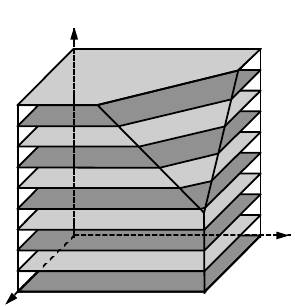
6.1 Characterization of Microstructure and Texture 533
[100]
[010]
[001]
FIGURE 6.16
Equidistant sections through Rodrigues space perpendicular to [001].
cell. As a density function the MODF has to be normalized to unity
f (Δg) d (Δg) = 1 (6.30)
For a particular microtexture, however, it is also important to relate the
measured MODF to a reference MODF [577]. This reference may be either
a random misorientation distribution, which can be calculated analytically
according to Mackenzie, or which can be simulated from a set of random ori-
entations by computing the frequency of occurrence of any misorientation from
the set of misorientations, i.e. the misorientations of each orientation with all
other orientations in the set. If the texture of the specimen is not random,
then the orientation distribution can be discretized and the reference MODF
can be computed analogously. The corresponding misorientation distribution
is also referred to as orientation difference distribution function (ODDF). The
necessity for this normalization is easy to realize. If a texture would consist of
only two strong components, the probability to measure a misorientation re-
lationship between adjacent grains close to the ideal misorientation of the two
components is much higher than for a random texture. Any deviation from
unity of a MODF/ODDF indicates a nonrandom misorientation distribution.
A random MODF computed for a random orientation set is given in Fig. 6.1.
The MODF normalized by the ODDF is commonly termed orientation cor-
relation function (OCF). For illustration, a microstructure with many small
angle boundaries and first order twin boundaries is represented in terms of
MODF, ODDF and OCF in Fig. 6.19.
Every grain boundary manifests a misorientation between adjacent grains,
© 2010 by Taylor and Francis Group, LLC
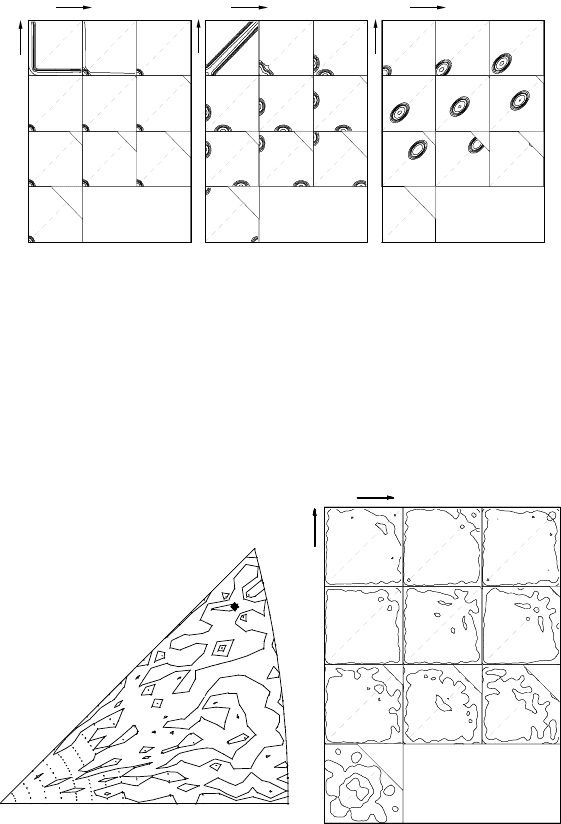
534 6 Applications
[
]
Probe: 100-Faser
Streubreite: 2°
Levels: 2 4 7 10 20 50
Maximum: 95
Schrittweite: 5° [001]
[
0
1
0
]
Probe: 110-Faser
Streubreite: 2°
Levels: 2 4 7 10 20 50
Maximum: 63
Schrittweite: 5° [001]
[
0
1
0
]
Probe: 111-Faser
Streubreite: 2°
Levels: 2 4 7 10 20 50
Maximum: 59
Schrittweite: 5° [001]
[
0
1
0
]
[
0
1
0
]
[
0
1
0
]
[100] [100][100]
sample: 100-fibre
scatter width: 2°
levels: 2 4 7 10 20 50
maximum: 95
step width: 5° [001]
sample: 110-fibre
scatter width: 2°
levels: 2 4 7 10 20 50
maximum: 63
step width: 5° [001]
sample: 111-fibre
scatter width: 2°
levels: 2 4 7 10 20 50
maximum: 59
step width: 5° [001]
FIGURE 6.17
Representation of orientation relationships in [001] sections of Rodrigues
space: rotations about (a) 100;(b)110;and(c)111 axes.
RD
<100> <110>
<111>
levels
0.50
1.00
2.00
(a)
[
0
1
0
]
[100
]
Probe: Fortunier
Streubreite: 2°
Levels: 0,5 1,0 1,8
Maximum: 1,9
Schrittweite: 5° [001]
[010]
[100]
sample: Fortunier
scatter width: 2°
levels: 0.5; 1.0; 1.8
maximum: 1.9
step width: 5° [001]
(b)
FIGURE 6.18
Random orientation distribution (a) in inverse pole figure; (b) in Rodrigues
space.
© 2010 by Taylor and Francis Group, LLC
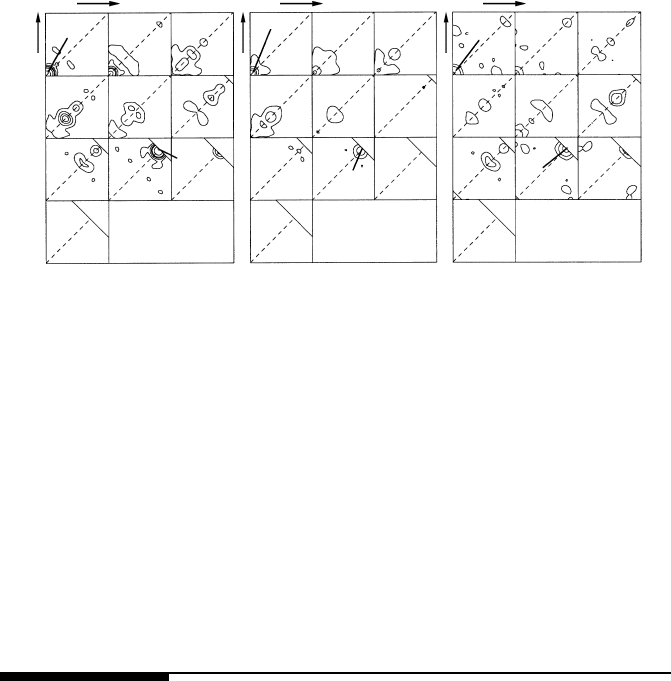
6.2 Recrystallization annd Grain Growth 535
[
0
1
0
]
[
0
1
0
]
[
0
1
0
]
[100] [100] [100]
KW
KW
KW
Z
Z
Z
sample: MODF
scatter width: 2°
levels: 2 4 7 10 20 50
maximum: 85
step width: 5° [001]
sample: OCF
scatter width: 2°
levels: 2 4 7 10
maximum: 15
step width: 5° [001]
sample: ODDF
scatter width: 2°
levels: 2 4 7 10
maximum: 15
step width: 5° [001]
FIGURE 6.19
Comparison of normalization principles (a) MODF; (b) ODDF; (c) OCF.
Small angle relationships (KW), first order twin relationships (Z).
by definition. If the character of a grain boundary can be reduced to its mis-
orientation, i.e. if the spatial orientation of the grain boundary plane can be
neglected, then the distribution of grain boundary character is represented by
the MODF. For a random distribution of all low Σ boundaries with Σ < 29,
where each misorientation was allowed to have a scatter of 5
◦
, the grain bound-
ary character distribution is given in Fig. 6.20.
6.2 Recrystallization annd Grain Growth
6.2.1 Phenomenology and Terminology of Recrystallization
and Grain Growth
The capability of metals to substantially change their properties during a
treatment have made metals and alloys the most versatile and most widely
used structural materials. The macroscopic property changes are mainly due
to either phase transformations or recrystallization and related phenomena.
In this context we will focus on the latter, in particular on recrystallization
and grain growth.
During plastic deformation of a metal due to cold or hot working, disloca-
tions are generated and stored in the crystal. Dislocations are lattice defects,
which do not occur in thermodynamic equilibrium, and, therefore, a deformed
solid tends to remove these lattice defects. On the other hand, although ther-
modynamically unstable, the dislocation arrangement of a deformed crystal
© 2010 by Taylor and Francis Group, LLC
